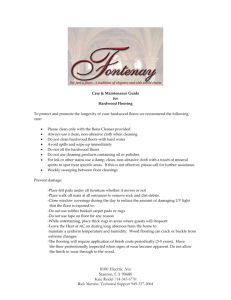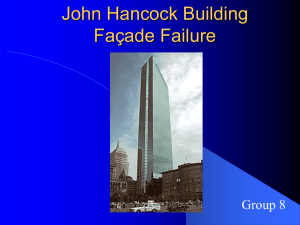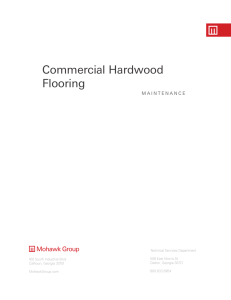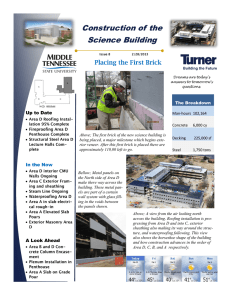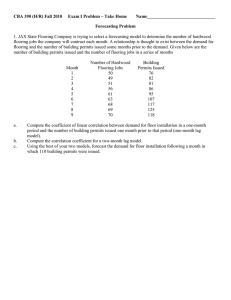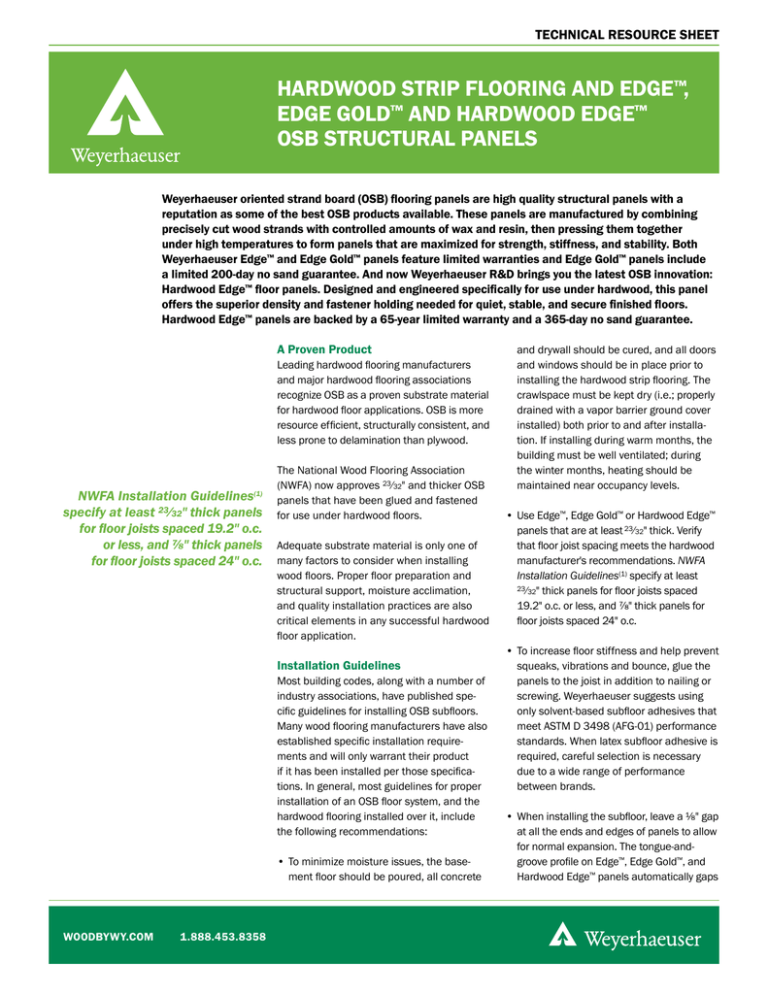
TECHNICAL RESOURCE SHEET
­ ardwood Strip Flooring and Edge™,
H
Edge Gold™ and Hardwood Edge™
OSB Structural Panels
Weyerhaeuser oriented strand board (OSB) flooring panels are high quality structural panels with a
reputation as some of the best OSB products available. These panels are manufactured by combining
precisely cut wood strands with controlled amounts of wax and resin, then pressing them together
under high temperatures to form panels that are maximized for strength, stiffness, and stability. Both
Weyerhaeuser Edge™ and Edge Gold™ panels feature limited warranties and Edge Gold™ panels include
a limited 200-day no sand guarantee. And now Weyerhaeuser R&D brings you the latest OSB innovation:
Hardwood Edge™ floor panels. Designed and engineered specifically for use under hardwood, this panel
offers the superior density and fastener holding needed for quiet, stable, and secure finished floors.
Hardwood Edge™ panels are backed by a 65-year limited warranty and a 365-day no sand guarantee.
A Proven Product
Leading hardwood flooring manufacturers
and major hardwood flooring associations
recognize OSB as a proven substrate material
for hardwood floor applications. OSB is more
resource efficient, structurally consistent, and
less prone to delamination than plywood.
NWFA Installation Guidelines(1)
specify at least 23 ⁄ 32" thick panels
for floor joists spaced 19.2" o.c.
or less, and ⅞" thick panels
for floor joists spaced 24" o.c.
The National Wood Flooring Association
(NWFA) now approves 23 ⁄ 32" and thicker OSB
panels that have been glued and fastened
for use under hardwood floors.
Adequate substrate material is only o
­ ne of
many factors to consider when installing
wood floors. Proper floor preparation and
structural support, moisture acclimation,
and quality installation practices are also
critical elements in any successful hardwood
floor application.
Installation Guidelines
Most building codes, along with a number of
industry associations, have ­published specific guidelines for installing OSB subfloors.
Many wood flooring manufacturers have also
established specific installation requirements and will only warrant their product
if it has been installed per those specifications. In general, most guidelines for proper
installation of an OSB floor system, and the
hardwood flooring installed over it, include
the following ­recommendations:
•To minimize moisture issues, the basement floor should be poured, all ­concrete
Woodbywy.com
1.888.453.8358
and d
­ rywall should be cured, and all doors
and w
­ indows should be in place prior to
installing the hardwood strip flooring. The
crawlspace must be kept dry (i.e.; properly
drained with a vapor ­barrier ground cover
installed) both prior to and after installation. If installing during warm months, the
building must be well ventilated; during
the winter months, heating should be
­maintained near occupancy levels.
•Use Edge™, Edge Gold™ or Hardwood Edge™
panels that are at least 23 ⁄ 32" thick. Verify
that floor joist spacing meets the hardwood
manufacturer's recommendations. NWFA
Installation Guidelines(1) specify at least
23 ⁄ 32" thick panels for floor joists spaced
19.2" o.c. or less, and ⅞" thick panels for
floor joists spaced 24" o.c.
•To increase floor stiffness and help prevent
squeaks, vibrations and bounce, glue the
panels to the joist in addition to nailing or
screwing. Weyerhaeuser suggests using
only solvent-based subfloor adhesives that
meet ASTM D 3498 (AFG-01) performance
standards. When latex subfloor adhesive is
required, careful selection is necessary
due to a wide range of performance
between brands.
•When installing the subfloor, leave a ⅛" gap
at all the ends and edges of panels to allow
for normal e
­ xpansion. The tongue-andgroove profile on Edge™, Edge Gold™, and
Hardwood Edge™ panels automatically gaps
Hardwood Strip Flooring and Edge™, Edge Gold™, and Hardwood Edge™ OSB Structural Panels
the long edge of the panel. For improved
performance, the tongue-and-groove edges
should also be glued together.
The overall design of a floor
system — including joist depth,
spacing, and type of floor panel
used — plays a significant role in
the success of a hardwood
floor installation.
•For panels 1" thick or less, use 8d (0.131"
x 2½") nails to completely ­fasten the panel
to the joists. For panels thicker than 1",
use 10d (0.148" x 3") nails. Screws of an
equivalent root diameter and length may
be used instead of nails. When fastening
with screws, Weyerhaeuser recommends
using screws from a manufacturer that can
provide an ICC-ES Evaluation Report. Do
not use drywall screws.
Keep all fasteners at least 3⁄8" from panel
edges. Recommended maximum fastener
spacing is 6" o.c. along supported panel
edges and 12" o.c. along intermediate
supports (joists) in the panel field, unless
specified otherwise.
•As the sub-floor is installed, make sure it
stays level (no high or low spots) and sand
any raised joints flat. Lightly countersink
protruding nail heads and re-nail areas of
the subfloor as needed to help eliminate
nail pops and potential squeaks. With
screws, tighten heads slightly into panels
to ensure panels are securely fastened
against framing.
•Prior to laying the hardwood strips, floor
­panels should be free of debris and dust.
They should also be dry, with a moisture
content of not more than 4% over the
expected in-use average moisture content
of the flooring. See the following table.
•Hardwood is generally manufactured to a
­moisture content (MC) of 6%–9%, but it
can absorb moisture from humid air when
in storage and during shipping. Therefore,
schedule delivery of the hardwood only
after the house has dried. Unwrap flooring
and allow it to acclimate in the home
with the HVAC system operating prior to
installation.
Average Yearly MC for Wood in
Various North American Regions(2)
Region
Coastal
Inland
Drier Climates
Average MC Range of Wood (%)
8–12
6–10
5–9
During installation follow manufacturer
recommendation for acceptable differences in MC between subfloor and
acclimated flooring. Typically, the
difference in MC should be no more than
4% for solid strips less than 3" wide, and
no more than 2% for planks 3" and wider.
A moisture meter can be used to check
MC of subfloor and hardwood.
•Once the subfloor is properly prepared,
work area is enclosed, and hardwood strip
flooring is acclimated, it should be installed
by a professional following the recommendations of NWFA Installation Guidelines(1)
and/or the flooring manufacturer.
While these guidelines will help ensure a
successful hardwood floor installation, the
overall design of a floor system—including
joist depth, spacing, and type of floor panel
used—plays a significant role as well. For
additional information on installing
Weyerhaeuser Edge™, Edge Gold™, or
Hardwood Edge™ floor panels, visit
­woodbywy.com. In cases where a higher
performance floor is desired, call your
Weyerhaeuser sales representative for
design assistance.
References
1. N
WFA Installation Guidelines, National Wood Flooring
Association, 2011, nwfa.org.
2. Managing Moisture and Wood, Building Performance
Series No. 6, Canadian Wood Council, 2004.
For more information about storage, safety,
and installation of Weyerhaeuser OSB
flooring panels, see the Technical Resource
Sheet, Floor, Roof and Wall Panel
Installation OSB-4004 or contact your
Weyerhaeuser representative.
CONTACT US
1.888.453.8358
woodbywy.com
September 2013
Reorder SR-112
This document supersedes all previous versions. If this is more
than one year old, contact your dealer or Weyerhaeuser rep.
wood@weyerhaeuser.com
and Weyerhaeuser are registered trademarks, and Edge, Edge Gold, and Hardwood Edge are trademarks of
Weyerhaeuser NR. © 2013 Weyerhaeuser NR Company. All rights reserved.

